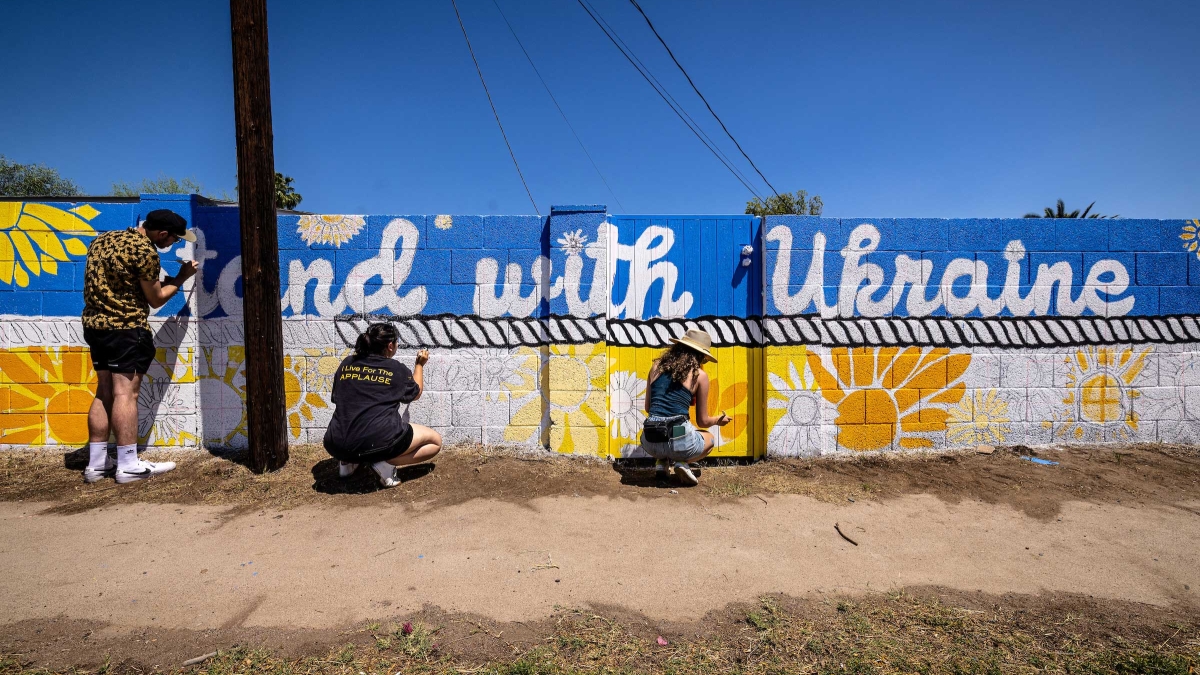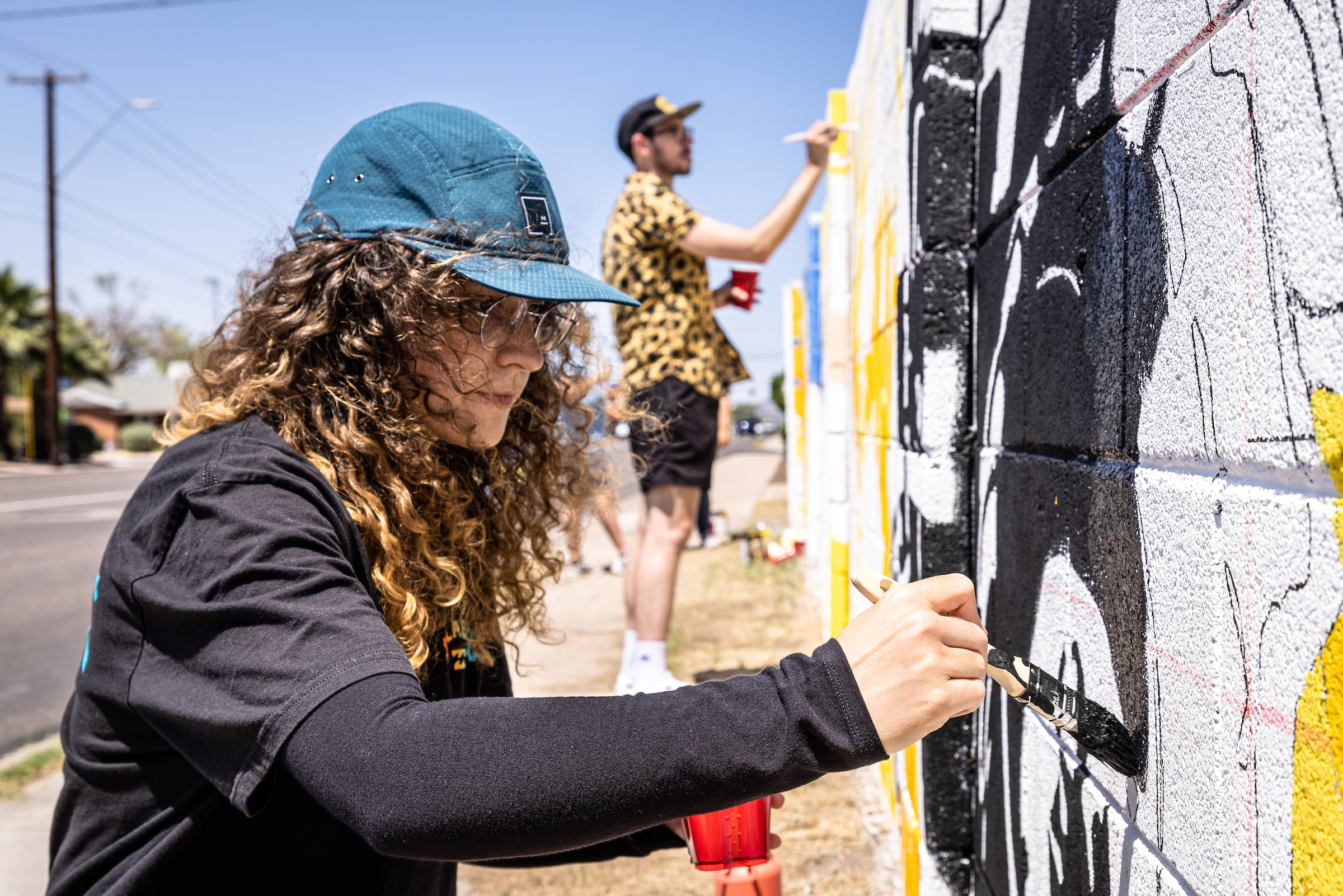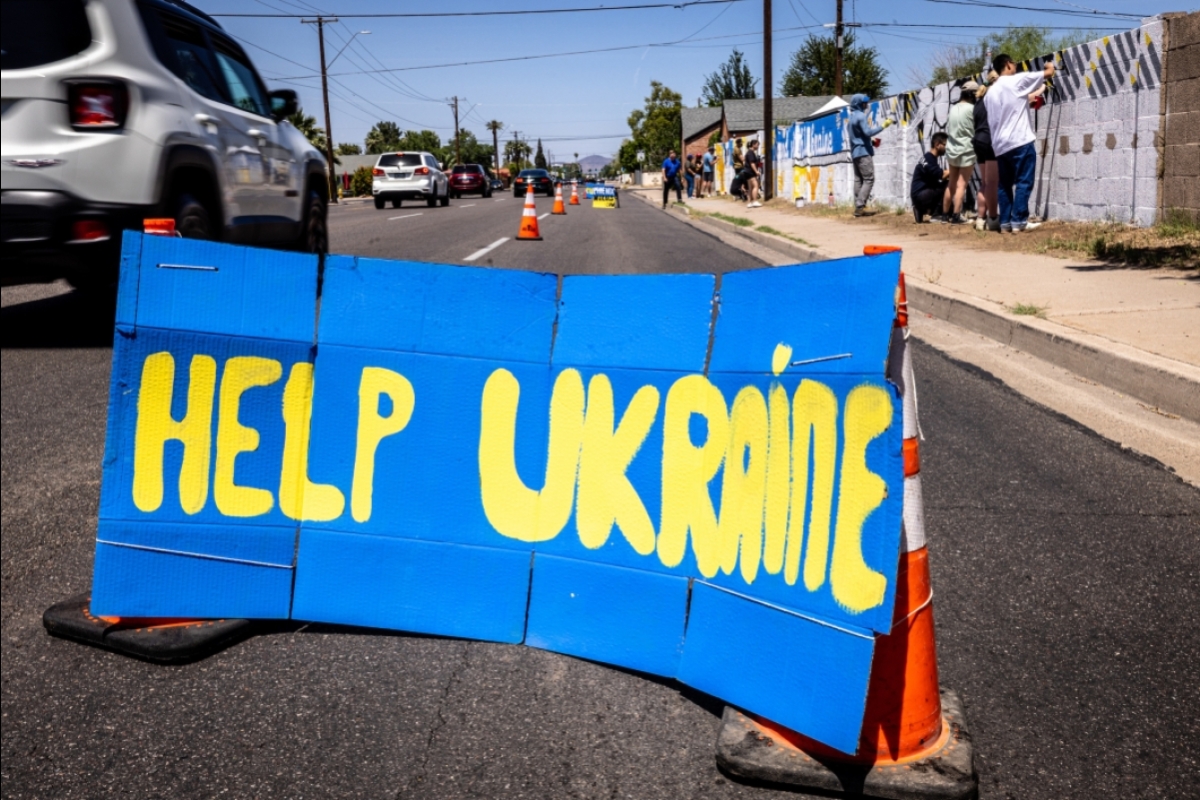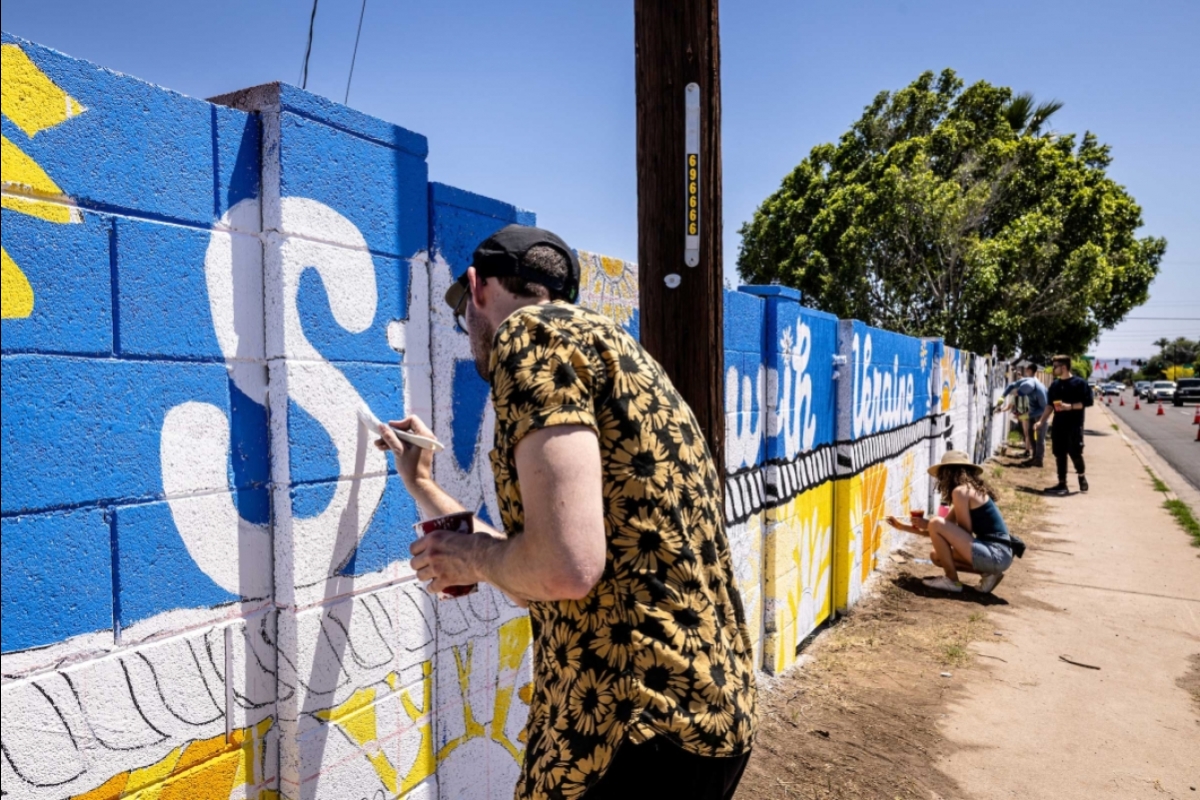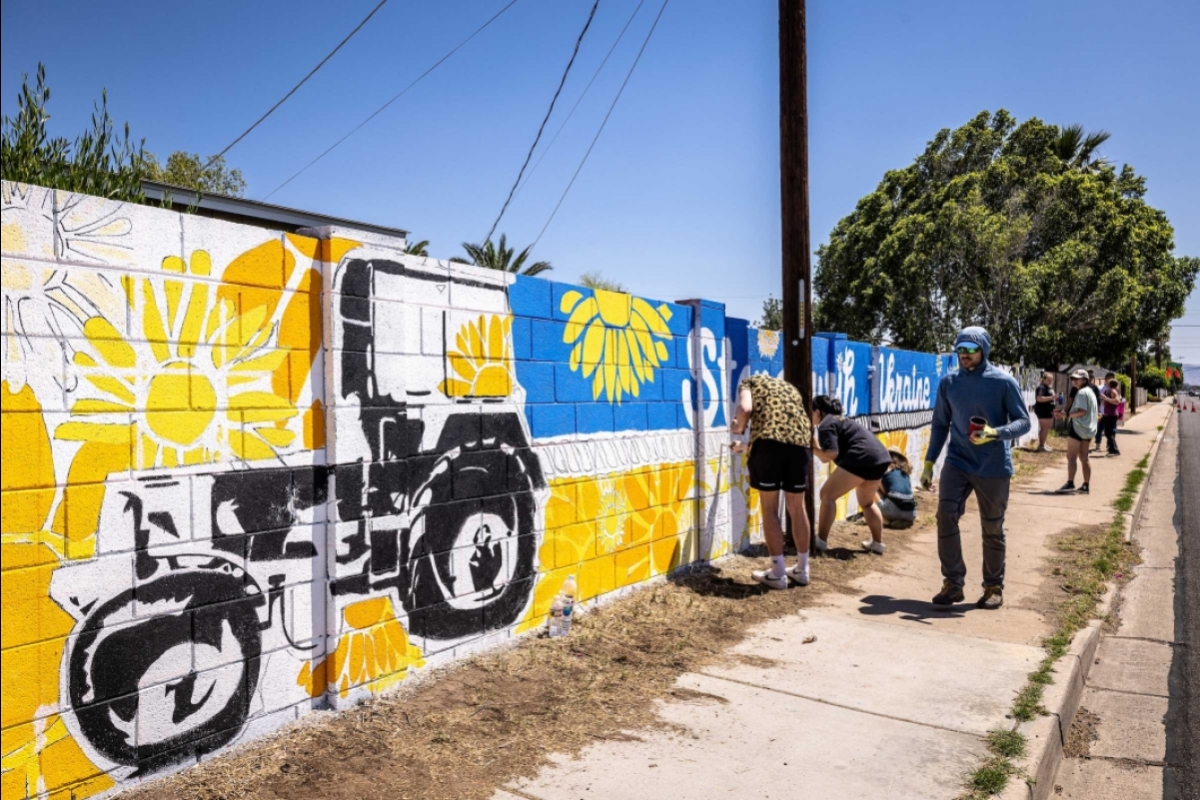A group of Arizona State University students painted a colorful mural in central Phoenix over the weekend supporting the people of Ukraine in their resistance to the Russian invasion.
The mural, on a wall on the east side of Seventh Avenue just north of Encanto Boulevard, is in the bright blue and yellow colors of Ukraine’s flag and includes the country’s symbol, the sunflower, and the words “Stand With Ukraine.”
Iryna Demianiuk, who is graduating with a master’s degree in architecture this semester, is from Ukraine and led the effort in her Subversive Design class in The Design School.
Several of her classmates, along with some members of the newly formed Ukrainian Association of ASU and a few volunteers, completed the mural over three weekends, finishing last Saturday.
“The Ukrainian Association of ASU started talking about how we could bring more awareness of Ukraine to the community in Phoenix,” she said.
“So I had this idea of engaging my classmates, and I’m happy they agreed to participate.”
ASU student Iryna Demianiuk helps paint a "Stand with Ukraine" mural in central Phoenix on April 23. Photo by Charlie Leight/ASU News
The Ukrainian Association of ASU came up with some ideas for a mural, which includes an image of a Ukrainian farm tractor towing a Russian tank, and the class created a digital model. The students spent two weekends sketching the design on the wall in front of two homes on Seventh Avenue and then painted it in last Saturday. The two homeowners and the city of Phoenix gave their approvals.
“’Stand with Ukraine’ is the main tag that’s been around for years,” Demianiuk said. “The war has been happening in our country for eight years, since 2014, and not that many people know that unfortunately. Now more people are aware, but we still wanted to bring it more to light.”
Demianiuk visited family and friends in Ukraine over winter break. The start of the invasion in February was very difficult for her.
“There are no words to explain it. For the first months, it was terrible,” she said.
“Now we are kind of adjusting and finding our positions in this situation, and trying to help as much as we can.”
The Subversive Design class is taught by Danielle Foushée, an assistant professor in the Design School, director of the Subversive Creativity Lab at ASU and founder of the Phoenix Mural Project, a public art initiative.
“I started the Phoenix Mural Project in 2016 when I came to ASU because I have always been all about public art for my research and creative practice,” she said.
Foushée had just finished a 12,000-mile road trip to look at public art around the West. During that trip and after she moved to Phoenix, she noticed the many murals around the city.
“But there was no information or map. There was nothing. So I started taking photos. And then I had 400 photos that were geotagged,” she said.
So she created the online resource of a Google map of photos, that now include 700 murals. She also held mural festivals in 2018 and 2021, bringing together dozens of artists to create murals around the city.
The paint and supplies for the “Stand With Ukraine” mural came from the Phoenix Mural Project and donations, including Ace Hardware.
ASU's Subversive Design course looks at design practices through a social justice lens.
Clare Witt, a graduate student in visual communication, is in the class and was among the participants at the mural painting last weekend.
“We were talking about murals in the class and we wanted to find a topic that we were passionate about,” she said.
“And when (Demianiuk) came up with the idea, we were like, ‘Yes we want to support this and make an awesome mural at the same time.’”
"I am inspired every day by the dedication of our students, faculty and staff to make a better world through design," said Paola Sanguinetti, director of The Design School.
"Professor Danielle Foushée is actively engaged with our local communities and teaches all her classes through a lens of empathy. This mural is a wonderful example of how our faculty and students at The Design School use their voice to shed light on global issues that impact all of us," Sanguinetti said.
Demianiuk said she wanted the mural to be cheerful and not tragic.
“I really want to remind people about the strength of the Ukrainian people,” she said.
“We are united and strong in our effort of protecting freedom and justice, and that’s what makes me speak up and try to engage more people.”
After she graduates, Demianiuk hopes to work in the U.S. for a few years before returning to Ukraine.
“I know that I can do a lot there as an architect,” she said. “I can be a part of rebuilding our cities.”
DONATE: For those that are interested in donating, the students are raising money to assist in relocating Ukrainians.
More on Ukraine
- Questions and answers from Melikian Center
- Trauma on Ukrainians will 'last a lifetime,' expert says
- How to talk to children about war in Ukraine
- Tiny Ukrainian island's long history
- ASU alum's lyrical novel explores a time of revolution in Ukraine
- Panel of ASU, UA professors discuss war
- Alumna using network, language skills to help besieged Ukrainians
- Q&A: How effective are economic sanctions?
- Russian journalist fears Putin won't stop attacks on Ukraine
- Faculty member helps Ukrainian refugees at Poland train station
Top photo: Students from the Herberger Institute for Design and the Arts, the Ukrainian Student Association and a few volunteers paint a “Stand with Ukraine” wall mural on Seventh Avenue, south of Thomas Road, in Phoenix on Saturday, April 23. Photo by Charlie Leight/ASU News
More Arts, humanities and education

ASU graduate education programs are again ranked among best
Arizona State University’s Mary Lou Fulton College for Teaching and Learning Innovation continues to be one of the best graduate colleges of education in the United States, according to the…
ASU FIDM students to see their designs on the runway at Uncertainty Fashion Showcase
Nola Hill is perfecting every stitch of her fashion design collection, which she started conceptualizing last summer.She is among 30 ASU FIDM fashion design students who have been working late into…

ASU+GSV Summit brings experts together to discuss innovation in education
This week, Arizona State University President Michael Crow and other university leadership joined education and learning experts from around the globe at the ASU+GSV education technology summit in…


